
Catalog excerpts
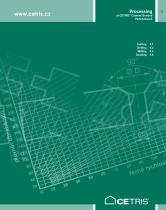
of CETRIS Cement Bonded Particleboard ® Cutting Drilling Milling Sanding
Open the catalog to page 1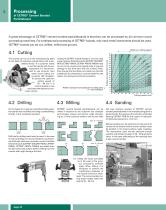
of CETRIS® Cement Bonded Particleboard A great advantage of CETRIS® cement bonded particleboards is that they can be processed by all common wood processing machines. For professional processing of CETRIS® boards, only hard metal instruments should be used. CETRIS® boards can be cut, drilled, milled and ground. Optimum cutting speed 4.1 Cutting Cutting of CETRIS® boards results in very fine dust waste. Surface finished boards (CETRIS® DOLOMIT NEW, CETRIS® FINISH, CETRIS® PROFIL FINISH) must be cut on the reverse (not treated) side to prevent damage to the front face with the surface finish....
Open the catalog to page 2
Fastening of CETRIS Cement Bonded Particleboard ®
Open the catalog to page 3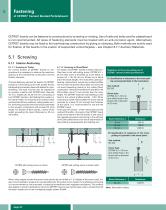
CETRIS® boards can be fastened to constructions by screwing or riveting. Use of nails and bolts used for plasterboard is not recommended. All types of fastening elements must be treated with an anti-corrosion agent. Alternatively CETRIS® boards may be fixed to the load-bearing construction by gluing or clamping. Both methods are mainly used for fixation of the boards in the system of suspended vented fagades - see Chapter 8.7.7 Auxiliary Materials. 5.1 Screwing 5.1.1 Interior Anchoring 5.1.1.1 Screwing to Timber For correct fixation of CETRIS® boards to constructions it is necessary to...
Open the catalog to page 4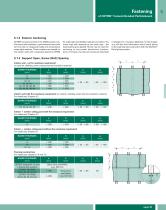
5.1.2 Exterior Anchoring CETRIS® boards are fixed in the VARIO system (visible joints) with stainless or galvanized screws with semi-circular or hexagonal heads and compressive water-tight washers. These washers are treated on the bottom side with vulcanized elastomer EPDM for water-tight and flexible material connection. The screw type also depends on the base type - the load-bearing grid applied. Rivets may be used for anchoring to zinc-coated (aluminium) constructions. The types of screws and rivets are described in Chapter 8.7.7 Auxiliary Materials. In that chapter you will also find...
Open the catalog to page 5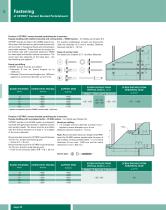
Fixation of CETRIS® cement bonded particleboards in exteriors Fa§ade cladding with visible horizontal and vertical joints - VARIo system - for details see Chapter 8.3 CETRIS® boards are fixed in the VARIO system (visible joints) with stainless or galvanized screws with semi-circular or hexagonal heads and compressive water-tight washers. These washers are treated on the bottom side with vulcanized elastomer EPDM for water-tight and flexible material connection. The screw type also depends on the base type - the load-bearing grid applied.* Board pre-drilling CETRIS® boards must be...
Open the catalog to page 6
Surface Finishes of CETRIS® Cement Bonded Particleboard Joint filling with permanently elastic filler 6.1 Paints 6.2 Interior plasters 6.3 Exterior plasters 6.4
Open the catalog to page 7
When applying surface finishes to CETRIS® cement bonded particleboard the following principles must be observed: • All applied materials must be stable in an alkali environment • Before application of paints, glues or plasters on CETRIS® boards the boards must be covered with a primer for absorptive surface • The materials must be applied to a dry board surface in compliance with the technological procedures required by the material manufacturers • It is not recommended to apply hard materials but rather permanently elastic materials • Dilation joints between boards may be covered laths or...
Open the catalog to page 8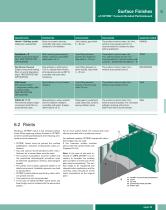
Surface Finishes of CETRIS® Cement Bonded Particleboard 01 CETRIS® cement bonded particleboard 02 primer 03 top coat 04 permanently elastic joint filler 05 dilation joint Painting a CETRIS® board is the simplest surface finish. When applying surface finishes to CETRIS® cement bonded particleboards the following principles must be observed: • CETRIS® board must be primed (for surface stabilisation, reduction of absorption, base unification) • Top coat colours recommended by their manufacturers for a cement base must be used • The product composition must be unified and the prescribed...
Open the catalog to page 9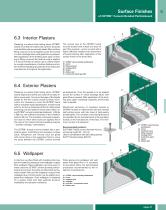
Surface Finishes of CETRIS Cement Bonded Particleboard ® 6.3 Interior Plasters Plastering is surface finish hiding joints. CETRIS® boards must first be treated with a primer, the joints must be filled with permanently elastic filler, and then filling compoud is to be applied across the surface in which bandage fabric with glass fibre is pressed. After application of the levelling layer again consisting of filling compoud the final top coat is applied. It is recommended to always use a unified system by a single manufacturer of surface finishes and observe the technological procedures of the...
Open the catalog to page 11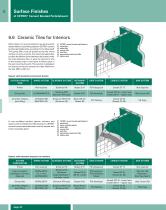
of CETRIS® Cement Bonded Particleboard 6.6 Ceramic Tiles for Interiors When tiling, it is recommended to use permanently elastic fillers for joint filling between CETRIS® cement bonded particleboards, as well as for the tiling itself. The gluing filler must be spread across the whole surface not only in points. It is recommended either to place the dilation joints between the boards under the ones between tiles, or glue the tile just to one of the boards under it and leave it without glue in the part covering the joint. This solution is designed for spaces commonly exposed to water. Maximum...
Open the catalog to page 12All Cetris catalogs and technical brochures
-
Technical manual
208 Pages
-
CETRIS® LASUR
1 Pages
-
CETRIS® DEKOR
1 Pages
-
Floor panel CETRIS® PDI
4 Pages









